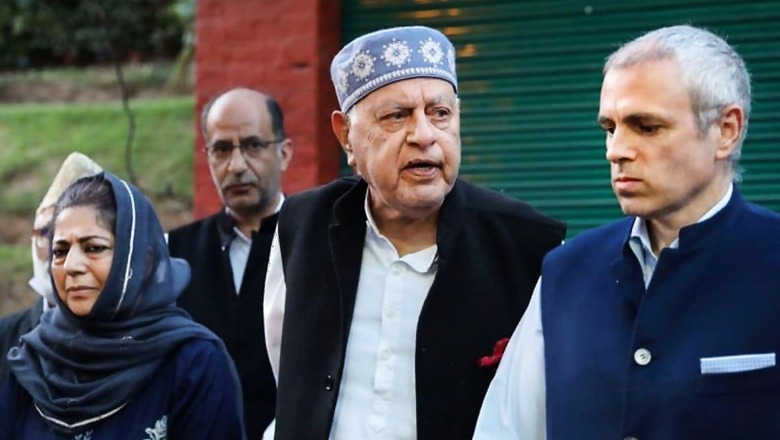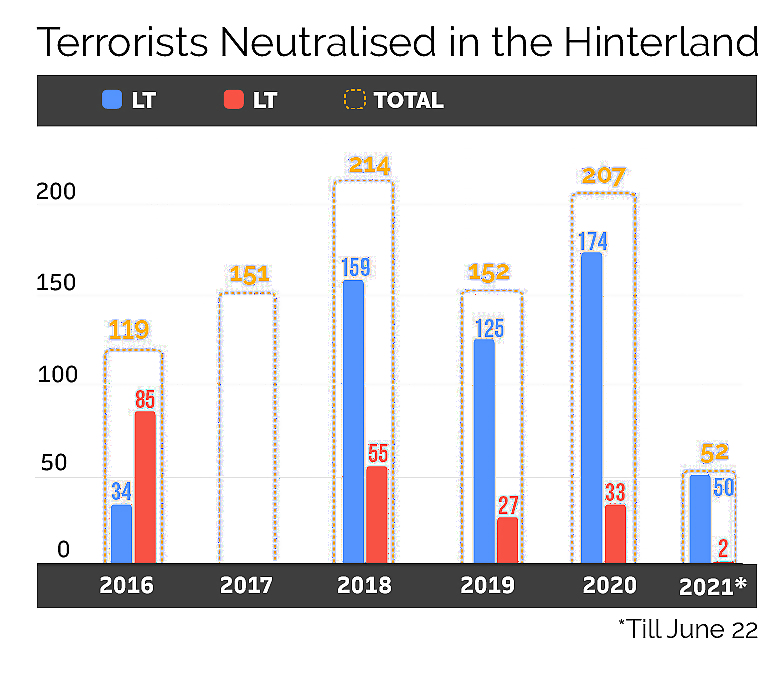
views
The leaflet was glued on to the signboard that welcomes students into the Government Boys High School in the small mountain village of Radbugh on Tuesday, next to the homilies painted on the walls for their edification. “Better to serve in heaven than to reign on earth”, one reads; “Silence is the womb of language”. This message was different: “We invite our people to avenge each drop of blood shed by our martyrs for the glory of Islam and to end India’s military occupation of Kashmir”.
Leaders of Jammu and Kashmir will arrive in New Delhi on Thursday for a meeting with Prime Minister Narendra Modi that is widely expected to initiate the reconstruction of its political system. The restoration of Kashmir’s statehood, elections, and even the special Constitutional status abrogated in 2019 will be raised.
The real issue, though, goes deeper than who will hold power in Kashmir, and on what terms. Leading up to the implosion of Kashmir’s state government in 2018, and imposition of central government rule, pro-India political parties like the National Conference and People’s Democratic Party became increasingly discredited. New Delhi’s efforts to engineer the emergence of a new political leadership since 2018 have had little success, either.
The gaggle of teenagers who pasted leaflets on the Boys High School shows that Islamists are cashing in on the political vacuum, capitalising on grievances over poor governance, economic deadlock and political disenfranchisement.
In the early 1990s, as a great tide of blood washed over Kashmir, Radbugh was almost untouched. Not a single resident of the village was killed in the long jihad which began in 1989. Now, the leaflets show, a new generation might have begun marching walking a dangerous path.
Figures from the Jammu and Kashmir Police illustrate the concerns. In 2016 — the year jihadist social-media icon Burhan Wani’s death in a shootout with police sparked a violent, Islamist-led uprising that swept the Indian state out from large parts of southern Kashmir — 88 new recruits were added to Kashmir-based terrorist groups. Last year, in spite of a grinding internet shutdown and Covid lockdowns, the number had risen to 184. Already, this year, the number is edging up to 90.

Although killings of terrorists have also been high — 174 ethnic-Kashmiri jihadists were shot last year, up from just 34 in 2016— levels of violence remain higher than in the five years before the 2016 uprising, data from the South Asia Terrorism Portal shows.
In spite of a chronic lack of weapons — only half of all terrorists killed in 2020 had a personal assault weapon — jihadists have succeeded in staging several successful attacks, targeting police patrols and political opponents. In several recent counter-terrorism operations, clashes have broken out between stone-throwing mobs and police, reminiscent of the situation before 2019.

Little success has been registered, moreover, in transfiguring Kashmir’s administration; complaints about unresponsive bureaucrats and poor project execution are commonplace. Kashmir’s economy, moreover, has come under severe pandemic-linked pressure; hopes of rapid and transformative development have receded.
The take-away is a simple one: the new status-quo in Kashmir is a fragile one. In 2008, 2010, and again 2016, long periods of peace were torn apart by mass violence, driven by ethnic-religious issues. That risk remains, in the absence of solid political foundations.
Prime Minister Modi’s meeting with Kashmir leaders seeks exactly that end, in the process bringing secret diplomacy steered by Pakistan Army chief Qamar Javed Bajwa and National Security Advisor Ajit Doval out of the shadows.
Ever since 2018, as first revealed by News18, secret contacts began between the Research and Analysis Wing and the Inter-Services Intelligence Directorate, aimed at peacebuilding in Kashmir. The Pulwama bombing — followed by airstrikes in both Pakistan and India — interrupted these secret negotiations. However, pushed by the United States and the United Arab Emirates, the RAW-ISI contacts resumed, yielding this year’s ceasefire on the Line of Control.
In April, following a briefing by a senior Pakistani official — by the account of two Government sources, General Bajwa himself — media in that country reported that Islamabad’s “primary interest at this initial stage is that Occupied Kashmir gets back its statehood and India agrees not to bring about any demographic changes in the disputed territory”.
Even though Indian audiences — conditioned by the acid polemic directed at the National Conference and PDP by senior Bharatiya Janata Party leaders — might find it implausible, neither of Islamabad’s demands is out of reach.
Prime Minister Modi himself promised Jammu and Kashmir’s statehood would be restored when conditions allowed. Notwithstanding the termination of Kashmir’s special Constitutional status, moreover, multiple Indian states—from Nagaland to Himachal Pradesh—have special legal protections against acquisition of land by non-residents.
Left to itself, the Indian government likely wishes to concede somewhat less. Among other ideas, statehood with significant powers over law-and-order delegated to the central government, like Delhi, have been considered. Kashmiri leaders, though, argue this would leave them with no legitimacy—stripping the entire democratic project of its raison d’être.
In theory, there’s no reason Kashmir’s political leadership, and the Prime Minister, can’t arrive at middle-ground that would let elections be held as early as this autumn. Even if the two sides do arrive at agreement, though, the road will be a long, hard one.
Faced with a push for independence by Kashmir’s political patriarch, Sheikh Muhammad Abdullah, Prime Minister Jawaharlal Nehru had sought to more tightly bind Kashmir to India’s Constitutional framework. In 1954, the central government gutted Article 370, passing constitutional amendments which expanded its jurisdiction to all subjects in the Union list of powers, and giving the Governor, rather than council of ministers, the final authority to interpret the constitution.
In the years after 1958, when Kashmir passed its own constitution, these powers would see India integrate Kashmir in all but name. From the constitution’s chapter on fundamental rights, to the jurisdiction of the central services, Election Commission and Supreme Court: India would exercise ever-tighter authority.
The day before Parliament abrogated Article 370, 260 of the 395 Articles in the Indian Constitution were already applicable in Jammu and Kashmir; the remaining 135 were Articles for which there are identical provisions in the constitution of Jammu and Kashmir.
Prime Minister Nehru’s hand-picked chief minister, GM Bakshi, sought to consolidate these changes with economic development and governance. Yet, in 1963, the theft of a relic from the shrine of Hazratbal exploded into Kashmir-wide anti-India violence. Following the crisis, the National Conference was dissolved, and replaced by the Congress. This further legitimised pro-independence politics, making it the sole platform for all resentments against the government.
Nehru’s policies, the historian Pran Nath Bazaz wrote in a letter to chief minister GM Sadiq, failed because they did not secure the “reconciliation of local nationalism with Indian nationalism”. Leaders, he argued, needed to “wisely strike a balance between the demands and emotions of the Indians, and the aspirations, urges and sentiments of the Kashmiris”.
In 1975, Prime Minister Indira Gandhi returned Sheikh Abdullah to power after an agreement which limited the state’s autonomy to legislation on “matters like welfare measures, cultural matters, social security, personal law and procedural laws”.
The central government’s choke-hold on Kashmir politics, though, had a toxic impact on Kashmir politics. Election fraud, and the marginalisation of democratic political opposition through coercive means, ended up empowering Islamists. By the late 1980s, Indian democracy had undermined itself.
From 2001, Prime Minister Atal Bihari Vajpayee sought to rebuild the foundations of a genuinely competitive politics in Kashmir, encouraging the emergence of the PDP as platform for oppositional tendencies until then only represented by secessionism.
The effort, though, led nowhere, with both the National Conference and PDP seeking to outbid each other to win support from Islamists. This competition ended up catalysing the tragic violence of 2018, and led to the implosion of the democratic system. New Delhi’s imposition of central rule, and the abrogation of Article 370, administered a near-fatal blow to the political order.
For New Delhi, the choices going forward won’t be simple. In 2016, Kashmir’s major parties showed they’re willing to saw off the branch on which they sit, undermining both the Indian state and their own legitimacy. There’s no telling, either, how durable General Bajwa’s promises to rein-in violence will prove. Yet, New Delhi has been taught, more than once, that taking direct control of the state’s politics engenders dysfunction and violence.
The time to move forward, the posters in Radbugh show, isn’t infinite: the longer New Delhi waits, the more likely it becomes that a new youth cohort will be seduced by violence which has already consumed two generations.
Read all the Latest News, Breaking News and Coronavirus News here.




















Comments
0 comment